
- Category DevOps
- Language en
- Published date Apr 1, 2024
Ephemeral test environments for CI workflows
How to use vCluster and Argo Workflow to manage ephemeral test environments
Why do we need it?
Since the early 2000s, it was clear that monolithic applications needed to be more scalable to avoid hindering business growth. After a few years, in 2011, during a workshop of software architects near Venice, a new software architectural style was emerging: microservices. The micro-services architecture model can scale to meet business needs by running multiple copies of each service on as many servers as necessary; with separate teams working on each micro-service, productivity and ownership of the code increase, which can be challenging with a monolithic architecture. Therefore, it is essential to implement a micro-services architecture to enable scalability for the application and the team. But All that glitters is not gold! Are there any drawbacks to adopting this kind of approach? And what happens if we try it in the cloud-native world using Kubernetes environments? Everyone who has already followed this journey can witness the risk of building a nightmare called dependency hell.
Dependency hell is a colloquial term for the frustration of some software users who have installed software packages which have dependencies on specific versions of other software packages. The dependency issue arises when several packages have dependencies on the same shared packages or libraries, but they depend on different and incompatible versions of the shared packages. If the shared package or library can only be installed in a single version, the user may need to address the problem by obtaining newer or older versions of the dependent packages. This, in turn, may break other dependencies and push the problem to another set of packages.
During the software development lifecycle, one of the goals of every developer team is to develop and test their application using the correct version of dependencies like other application services or DBs.
How can I obtain a temporary environment to perform all these checks safely?
So, what’s the problem?
This kind of gap is a common scenario that usually requires many infrastructure resources to replicate all the dependencies in a separate environment. Preparing it locally on every developer device is typically impossible, and every team cannot quickly request a different Kubernetes cluster to proceed with all the required tests due to increased infrastructure costs. At the same time, performing all these tests on the primary test environment used by all the teams is not recommended to avoid invalidating other tests conducted at the exact moment.
Finding a solution: vCluster + Argo Workflow
Deeping dive into this use case, one of the possible solutions is to use vCluster powered by Loft. Using this tool, the user can create a temporary Kubernetes cluster inside an existing one. The virtual cluster has separate control plane APIs that can be exposed differently. VCluster is a valid option when multiple tenants must be managed with a single Kubernetes Cluster, sharing the same infrastructure. It’s easy to use and adopt by existing Kubernetes users, as it doesn’t require installing anything on your existing clusters. New vCluster users need no training, as they can access a standard Kubernetes API Server endpoint. In this experiment, I enjoy integrating this technology with Argo Workflow, a popular workflow execution engine for Kubernetes. This engine provides a way to efficiently configure the orchestration of the deployment, testing, and teardown processes. The tool lets the final user define processes drawing DAGs (Directed acyclic graph). This feature also supports complex scenarios where there is a requirement to maximize parallelism when running tasks. This combination offers a fast, cost-effective, and scalable solution, avoiding many of the day-2 activities required for creating and managing a new dedicated cluster every time. It’s typing time!!!
Demo Project
URL: https://github.com/banshee86vr/ephemeral-test-environment
Project structure:
.
├── argo-workflow
│ └── lang
└── hello-world-appargo-workflow: CI/CD pipeline templates folderlang: ArgoWorkflow Templates folder for supported languageshello-world-app: Go Hello world application that prints a beautiful octopus 🐙 in ASCII code
Requirements
- Minikube
kubectlcommand-line tool installed and configured to connect to your Kubernetes cluster.- Helm version
3.xinstalled.
Preparation steps
1. Start Minikube and install Argo Workflows using Helm
minikube start
helm repo add argo https://argoproj.github.io/argo-helm
helm install argo-workflows argo/argo-workflows -n argo --create-namespaceThis command installs Argo Workflows in the argo namespace of your Kubernetes cluster.
2. Verify the Installation
To check if the installation was successful, you can run:
kubectl get pods -n argoYou should see a list of pods running with names prefixed with workflow-controller and argo-server.
3. Patch argo-server authentication
As reported on the official documentation: https://argo-workflows.readthedocs.io/en/latest/quick-start/#patch-argo-server-authentication
The argo-server (and thus the UI) defaults to client authentication, which requires clients to provide their Kubernetes bearer token to authenticate. For more information, refer to the Argo Server Auth Mode documentation. We will switch the authentication mode to server so that we can bypass the UI login for now:
kubectl patch deployment \
argo-server \
--namespace argo \
--type='json' \
-p='[{"op": "replace", "path": "/spec/template/spec/containers/0/args", "value": [
"server",
"--auth-mode=server"
]}]'4. Access Argo Workflows UI (Optional)
Argo Workflows provides a web-based UI for managing and monitoring workflows. To access the UI, you need to expose it as a service:
kubectl port-forward svc/argo-server -n argo 2746:2746Now, you can access the Argo Workflows UI by navigating to http://localhost:2746 in your web browser.
5. Add privileges to Argo service accounts
Add these privileges to the Argo service accounts are recommended only for demo purposes. IT’S STRONGLY NOT RECOMMENDED TO REPLICATE THIS CONFIGURATION IN PRODUCTION ENVIRONMENTS.
This command adds cluster-admin clusterrole to argo:argo-server and argo:default. In this way, Argo Workflow can manage every kind of resource in every namespace of the cluster.
kubectl create clusterrolebinding argo-admin-server --clusterrole=cluster-admin --serviceaccount=argo:argo-server -n argo
kubectl create clusterrolebinding argo-admin-default --clusterrole=cluster-admin --serviceaccount=argo:default -n argoIn production environments, creating a dedicated role for these service accounts is strongly recommended, allowing only required verbs on the resources managed by the workflows.
6. Prepare secrets required by the pipelines
Just in case of a private Git repository, you can run this command to allow the clone command executed by the pipeline ci.yaml:
kubectl create secret generic github-token -n argo --from-literal=token=.........This command creates the secret that contains the credentials to push the Docker image to the registry:
export DOCKER_USERNAME=******
export DOCKER_TOKEN=******
kubectl create secret generic docker-config --from-literal="config.json={\"auths\": {\"https://ghcr.io/\": {\"auth\": \"$(echo -n $DOCKER_USERNAME:$DOCKER_TOKEN|base64)\"}}}"7. Add Argo WorkflowTemplate manifests
git clone https://github.com/banshee86vr/ephemeral-test-environment.git
cd argo/workflow
kubectl apply -f ci.yaml
kubectl apply -f lang/go.yaml
kubectl apply -f cd.yamlExecution steps
With all prerequisites met and Argo Workflows successfully deployed and configured, you dive into the execution steps to start creating and managing workflows.
8. Submit the CI pipeline
The CI pipeline performs these steps inside the ci.yaml manifest:
- Cloning Repository: Fetches the source code from the git repository.
- Building Application: Utilizes the GoLang template go.yaml to compile the Go application.
- Building and Pushing Docker Image: Packages the application into a Docker image and pushes it to the registry.
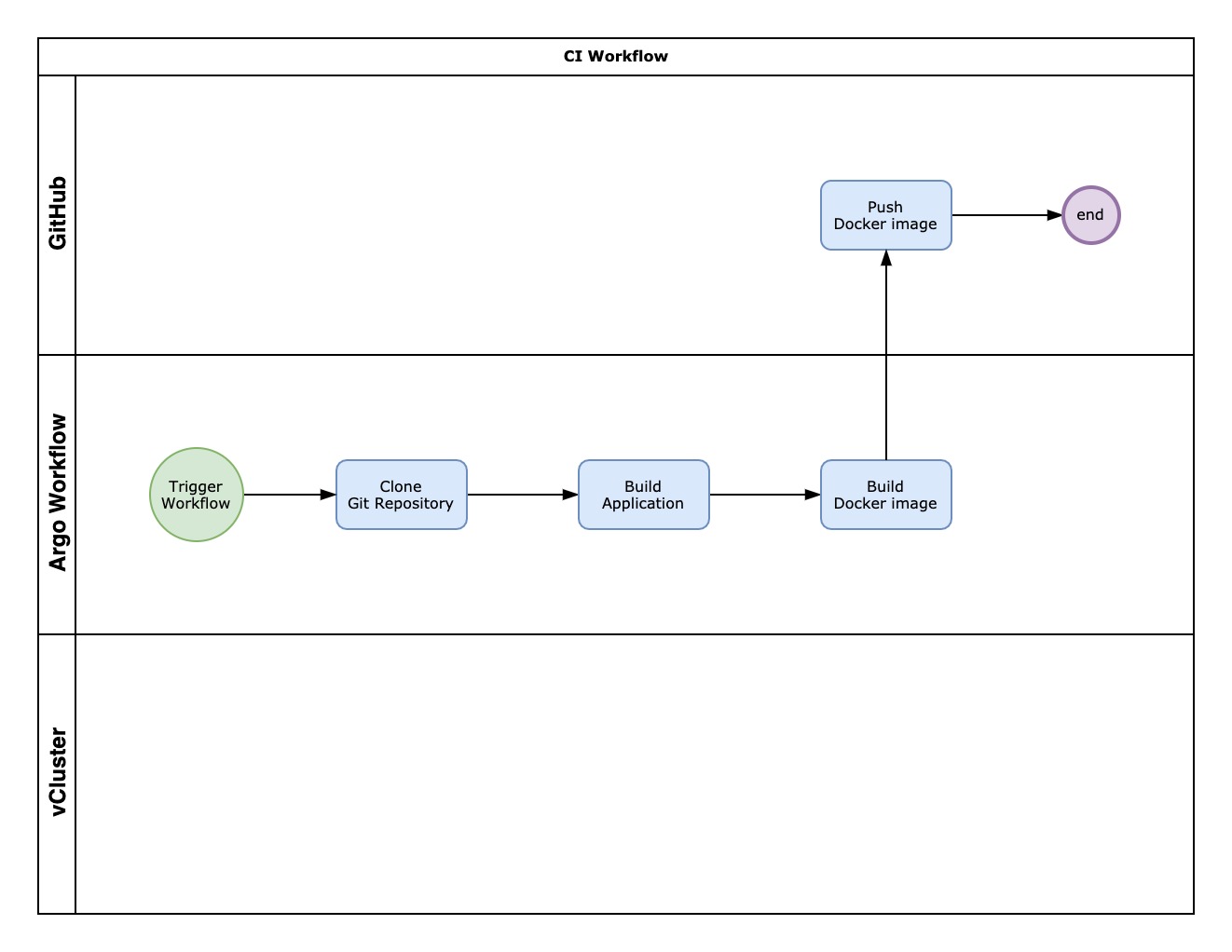
To submit the CI pipeline, you can use the official APIs:
<ArgoWorkflow URL>/api/v1/workflows/{namespace}/submitAlternatively, you can submit the workflow using the UI:
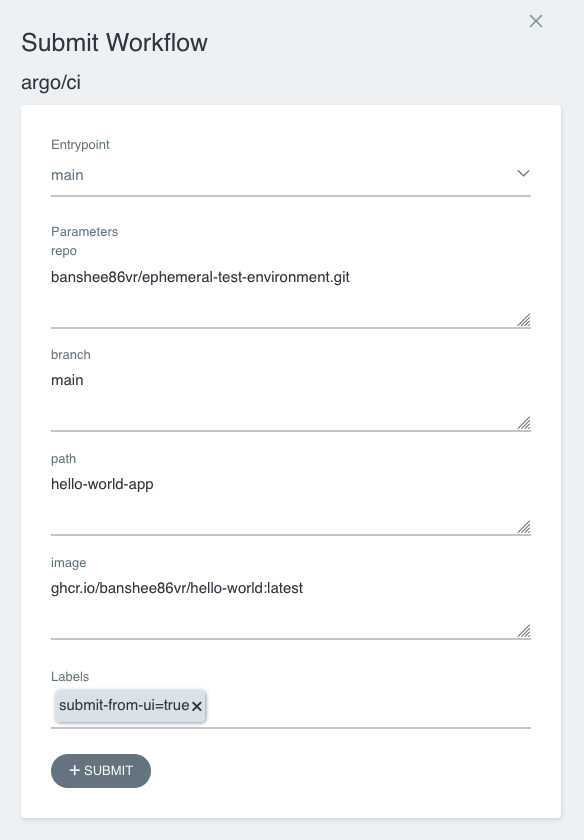
After the completion of all steps, you can check the correct status of every step and locate the updated Docker image in your registry:
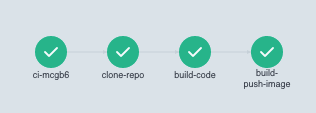
9. Submit the CD pipeline
The CD pipeline performs these steps inside the cd.yaml manifest:
- Preparing an ephemeral environment: Prepares a temporary environment using vCluster where the user can test the application inside an isolated Kubernetes cluster.
- Deploy the application: Deploy the application Helm chart on the vCluster just created.
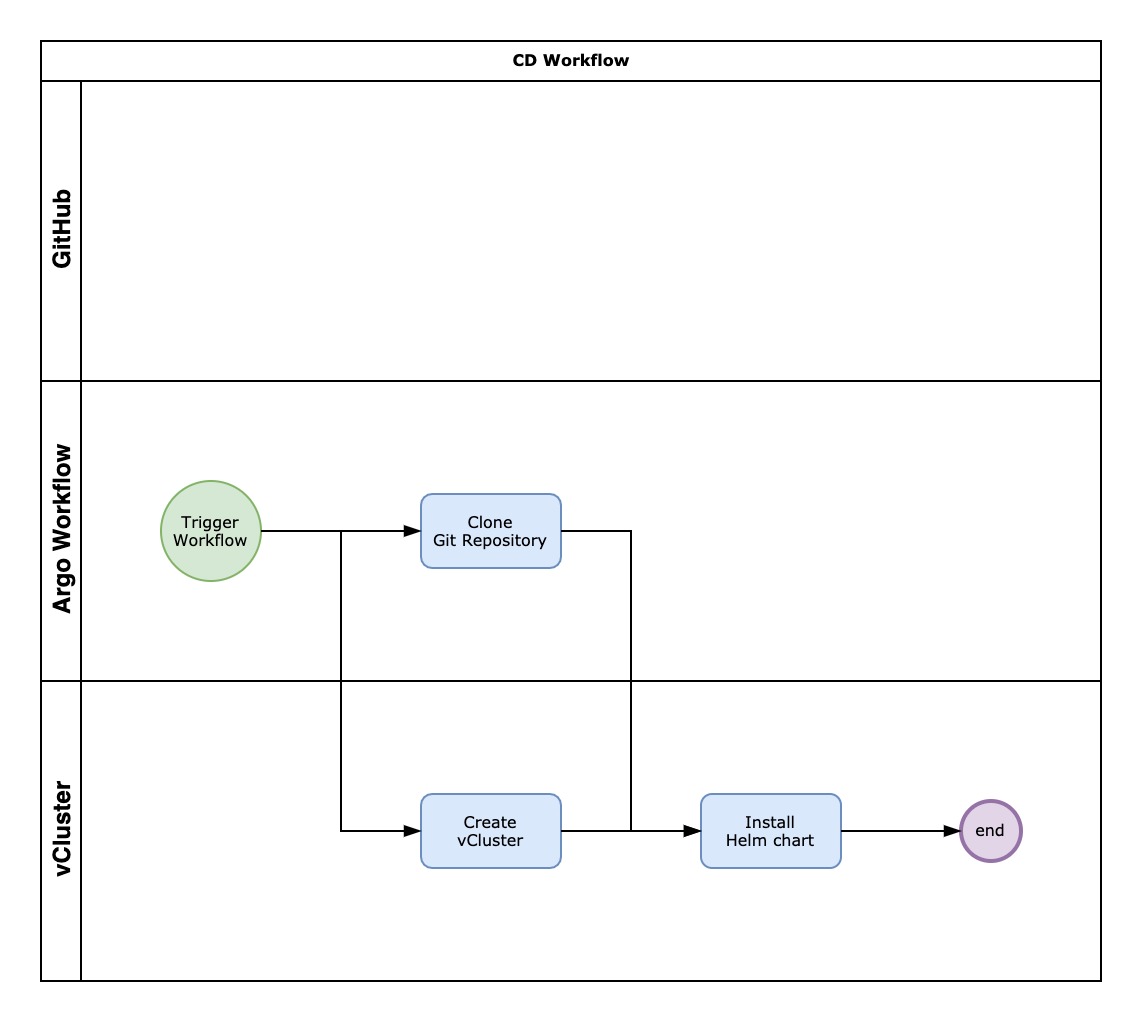
To submit the CD pipeline, you can use the official APIs:
<ArgoWorkflow URL>/api/v1/workflows/{namespace}/submitAlternatively, you can submit the workflow using the UI:
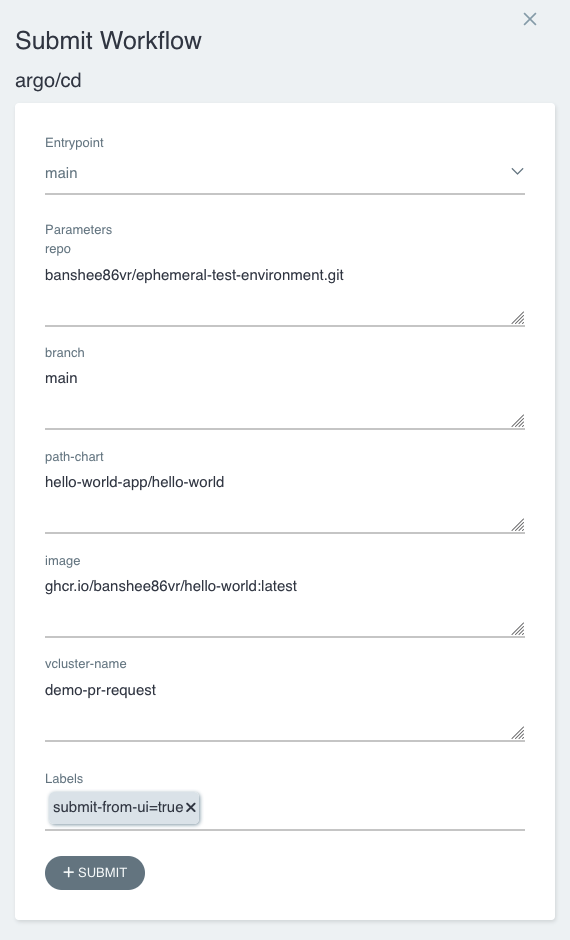
After the completion of all steps, you can check the correct status of every step:
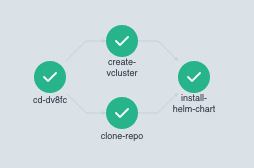
10. Access to the application
To check how to access the application deployed on vCluster, you can run these commands to list all vCluster and to access it:
$ vcluster list
NAME | CLUSTER | NAMESPACE | STATUS | VERSION | CONNECTED | CREATED | AGE | DISTRO
------------------+----------+-----------------+---------+---------+-----------+-------------------------------+---------+---------
demo-pr-request | minikube | demo-pr-request | Running | 0.19.0 | | xxxx-xx-xx xx:xx:xx +0100 CET | 1h8m49s | OSS
$ vcluster connect demo-pr-request --namespace demo-pr-request -- kubectl get pod -n demo-pr-request
NAME READY STATUS RESTARTS AGE
demo-pr-request-hello-world-7f6d78645f-bjmjc 1/1 Running 0 7sAs reported here, you can expose the ephemeral vCluster created differently.
-
Via Ingress: An Ingress Controller with SSL passthrough support will provide the best user experience. Ensure your ingress controller is installed and healthy on the cluster hosting your virtual clusters. More details here
-
Via LoadBalancer service: The easiest way is to use the flag
--exposein the vcluster create phase to tell vCluster to use a LoadBalancer service. It depends on the specific implementation of the host Kubernetes cluster. -
Via NodePort service: You can also expose the vCluster via a NodePort service. In this case, you must create a NodePort service and change the
values.yamlfile to use for the creation of the vCluster. More details here -
From Host Cluster: To access the virtual cluster from within the host cluster, you can directly connect to the vCluster service. Make sure you can access that service and then create a kube config in the following form:
vcluster connect my-vcluster -n my-vcluster --server=my-vcluster.my-vcluster --insecure --update-current=false
How have we filled the gap?
The demo project has demonstrated how easily it can be to integrate CI workflow using the Argo workflow engine by deploying an application in a temporary and isolated environment based on vCluster that includes all the dependencies. Furthermore, it’s essential to evaluate the possibility of customizing the initialization of the vCluster, applying .yaml manifests or helm charts. Typically, every microservice can have dependencies already packaged with another Helm chart or available with a .yaml manifest. With vCluster, the developer team can choose the chart version to init the vCluster to test the application.
How can we manage the lifecycle of this ephemeral vCluster?
During the demo project, we saw how to create a dynamically dedicated cluster on demand. But now we have to think about its management:
- How can I optimize the resources utilized by the vCluster?
- When can I delete the vCluster automatically?
- Can I automate everything, avoiding any manual operations?
- How can I prevent the proliferation of vClusters?
Loft guys help us to satisfy all these tricky topics. The OSS version is not enough to cover all of it, but let’s go step-by-step:
- Quotas and limits (available with OSS version): A Kubernetes standard
ResourceQuotamanifest applied in the namespace where the virtual cluster is running prevents the vCluster from consuming excessive resources in the host cluster. - Automated creation and deletion: These operations can be triggered using Argo Events. This event-driven workflow automation framework allows linking an event to the webhooks provided by the SCM tool, for example, about the change of the state of a pull request.
- Optimization of vCluster resources usage: about this topic, Loft provides a feature to monitor and manage the inactivity and avoid any waste of resources. The enterprise version of the tool (vCluster.PRO) offers two valuable functionalities that can help minimize Kubernetes expenses. Firstly, the
Sleep Modefeature enables virtual clusters to go to sleep mode when they are not being used, which means that all the pods are removed, but the resources are retained within the virtual clusters during the inactive period. Secondly, theAuto-Deletefeature automatically deletes virtual clusters that have been idle for a specific period. Suppose it’s not possible to adopt vCluster.PRO, there is a workaround using CronJob and the vCluster CLI Docker image scheduling the start and the sleep/resume of the cluster following the cron scheduling format.
What do we bring at home?
By integrating Argo Workflow with vCluster, we have implemented a fast and scalable solution, enabling each development team to test their applications independently in a secure and isolated environment. The possibility to customize the initialization of the vCluster permits the addition of any dependency needed, elevating the test quality performed on the deployed application.
The same architecture can also be event-driven by adding ArgoEvents, linking events to webhooks of the SCM tools, and making it a cost-effective solution.
Tags /
- vcluster /
- argo /
- cicd /
- devsecops /
- kubernetes /
- multi-tenancy /
